Posted by: Northwest Eye in General on May 28, 2025
Overview
This article explores the causes of constant urination in females, shedding light on factors such as:
- Overactive bladder
- Diabetes
- Aging
- Hormonal changes
We understand that experiencing these symptoms can be concerning and overwhelming. Recognizing these underlying issues is crucial, as it empowers women to seek timely medical intervention. By adopting lifestyle changes, women can alleviate symptoms and enhance their overall urinary health. Remember, you are not alone in this journey, and there are steps you can take to improve your well-being.
Introduction
In a world where health awareness is paramount, understanding bladder health is increasingly vital, especially for women. We know that as you navigate various life stages—from hormonal changes during menopause to the challenges posed by chronic conditions like diabetes—the significance of bladder health cannot be overstated.
This article delves into the multifaceted aspects of bladder health. It explores common issues such as:
- overactive bladder
- urinary incontinence
- the connections between diabetes and frequent urination
We understand that these topics can be overwhelming, but by highlighting the importance of patient education and proactive management strategies, we aim to empower you to take charge of your health.
Recognizing symptoms, seeking timely medical advice, and embracing effective treatment options are crucial steps. With insights from healthcare professionals and the latest research, this comprehensive guide serves as a crucial resource for women striving to maintain their quality of life amidst the complexities of bladder health. Remember, we are here to help you through this process.
Northwest Eye: Comprehensive Patient Education on Bladder Health
At Northwest Eye, we understand that your health concerns extend beyond just eye care. That’s why we emphasize thorough patient education, broadening our dedication to include vital information about urinary well-being, particularly for constant peeing female. We recognize that many women may feel uncertain about bladder issues, their causes, and the importance of seeking prompt medical guidance. Studies indicate that 50.6% of patients required home care after radical cystectomy with urinary diversion, highlighting the critical need for education on maintaining urinary health and understanding the potential repercussions of urinary problems.
To empower you, we provide informative brochures and easily accessible online content, enabling women to take charge of their well-being. It’s important to recognize symptoms like constant peeing female and to understand potential underlying conditions that may require further evaluation. Dr. Amy N Luckenbaugh emphasizes, “Health literacy also shows an impact on outpatient surgery recovery and care-related quality of life,” reinforcing the significance of health literacy in relation to urinary well-being.
Our case study, ‘Health Literacy and Hospitalization Rates,’ underscores the connection between and higher hospitalization rates. This highlights the importance of patient education in urinary wellness. By fostering an informed patient base, Northwest Eye not only enhances individual health management but also contributes to broader efforts in improving health literacy within our community. We are here to help you navigate this journey toward better health, aligning with our mission to provide comprehensive eye care services.
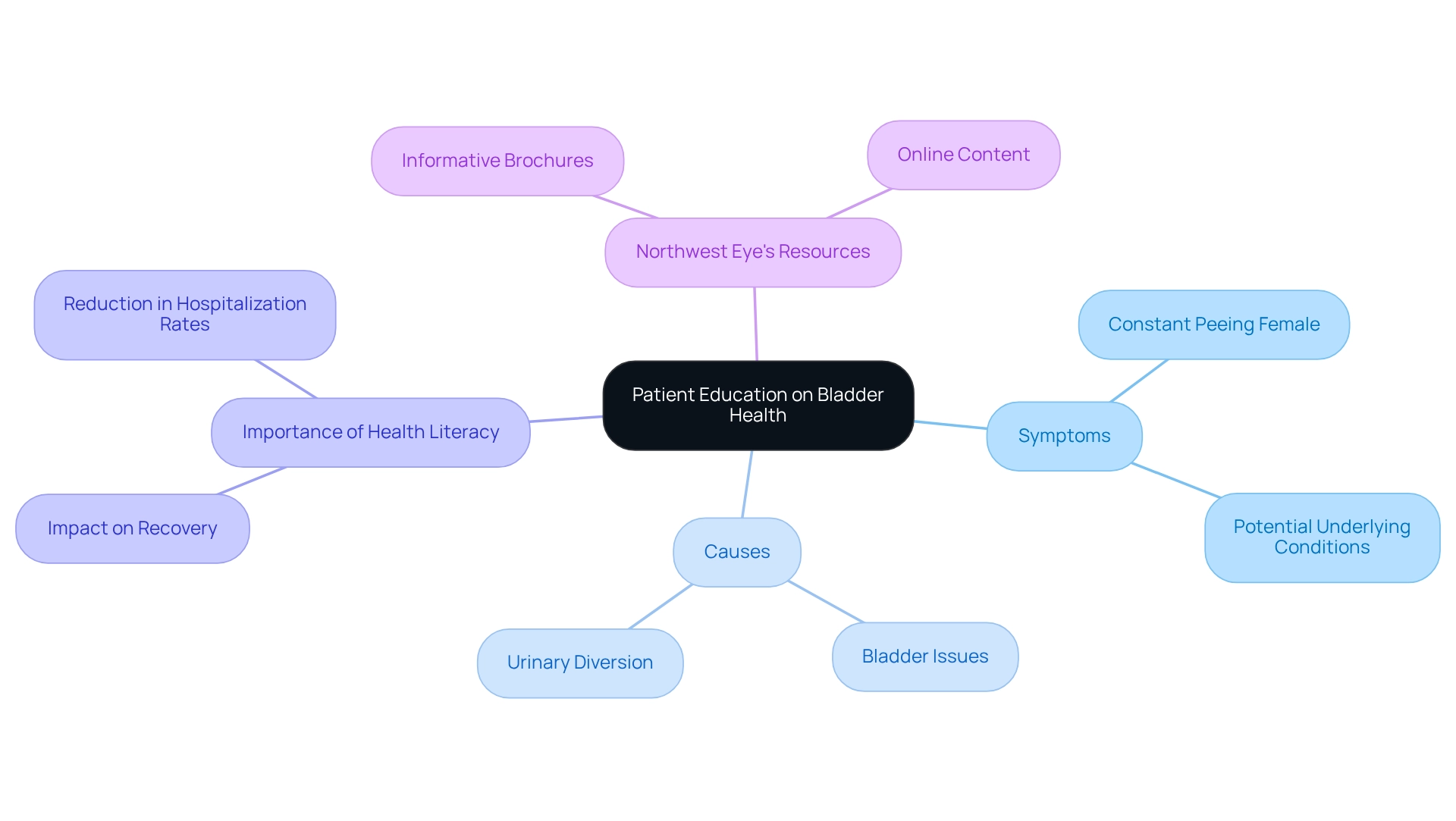
Overactive Bladder: Key Causes and Symptoms in Women
Overactive urinary function (OAB) can be quite distressing for a constant peeing female, characterized by a sudden, uncontrollable urge to urinate. This often leads to a constant peeing female and nocturia, which is the need to wake at night to relieve oneself. We understand that this condition can be influenced by various factors, including muscle overactivity, neurological disorders, and even lifestyle choices like high caffeine consumption. Women, in particular, may find themselves more vulnerable to OAB due to anatomical and , especially during times of hormonal change such as menopause. As Heather Ott, Senior Health and Science Educator at Uqora, insightfully points out, “Hormone level changes during menopause can influence urinary control, leading to increased urgency.”
Recognizing the symptoms of OAB early is crucial for effective management. Common symptoms often include a constant peeing female, which is a frequent need to urinate—typically more than seven times in a 24-hour period—and an urgent need to void that can lead to involuntary leakage. Understanding that normal urinary frequency is around seven times daily can help you assess your own habits. Current research highlights that making lifestyle modifications, such as reducing caffeine intake and maintaining a healthy weight, can significantly alleviate symptoms.
Successful treatment strategies for female patients often involve a combination of behavioral therapies, such as bladder training, and pharmacological interventions. We encourage you to explore educational resources, including symptom checkers and condition libraries, which can empower you to understand your health better and seek timely medical intervention. Case studies have shown that increased patient education correlates with improved management of OAB symptoms, fostering proactive health-seeking behavior. It’s important to remember that finding the right treatment for OAB may take time, and we encourage you to communicate any concerns with your doctor.
As awareness of OAB continues to grow, ongoing research is dedicated to investigating its prevalence and management approaches. We are committed to ensuring that you receive the support you need to maintain your quality of life.
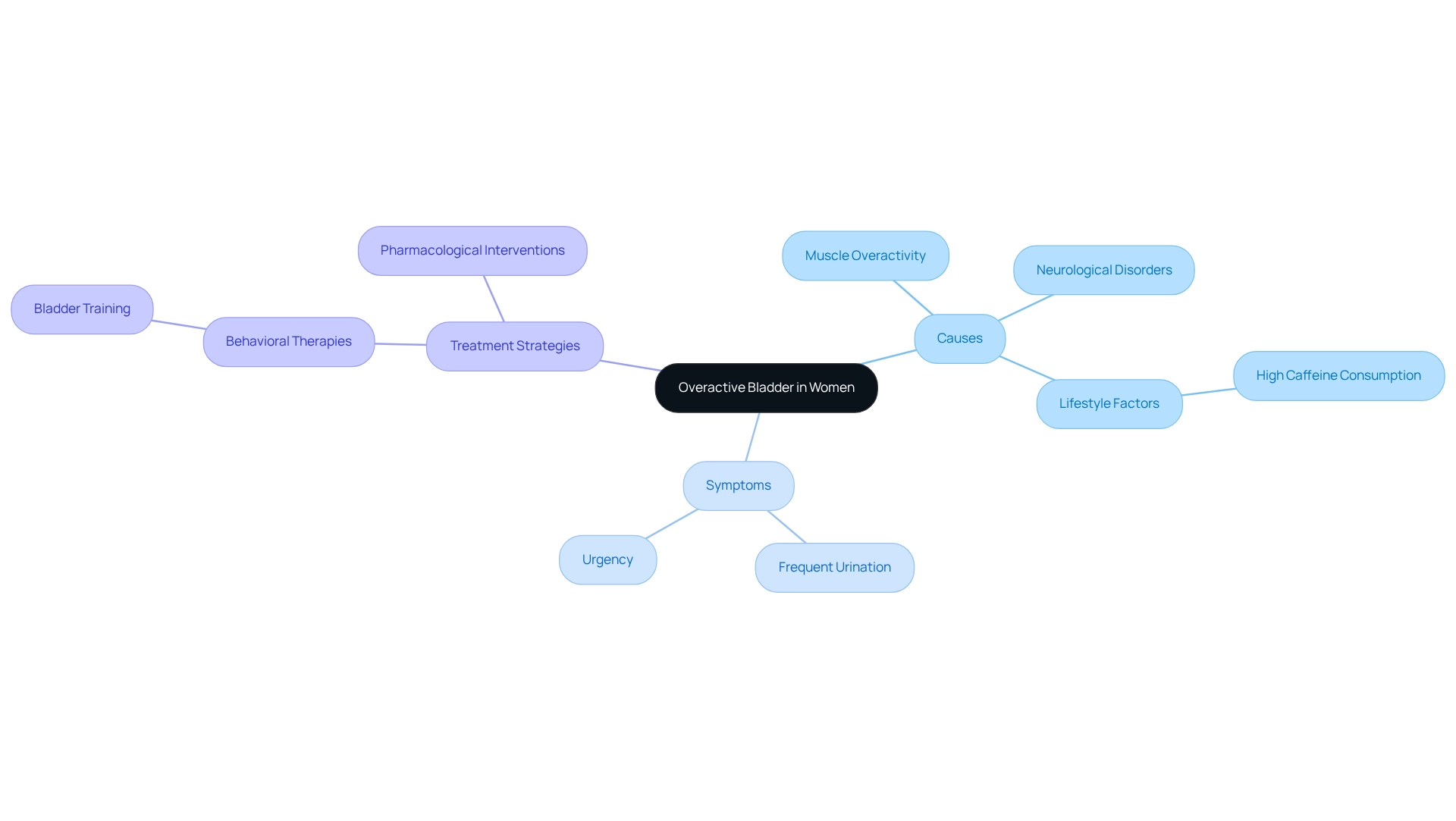
Diabetes and Frequent Urination: Understanding the Connection
Individuals living with diabetes often experience symptoms such as frequent urination, which can be referred to as constant peeing female, especially when blood sugar levels are not well managed. can lead the kidneys to produce more urine as they work to expel excess sugar from the bloodstream. This physiological response may cause significant bladder issues, particularly for women, leading to complications like urinary tract infections (UTIs), bladder dysfunction, and constant peeing female.
It’s important to note that statistics show women with diabetes are at a heightened risk for bladder-related complications, including constant peeing female symptoms, with studies indicating that nearly 20-40% of diabetic patients experience such symptoms. Additionally, those with diabetes often have higher rates of glaucoma and cataracts, which is especially concerning for cataract patients. Early signs of diabetes frequently include symptoms like constant peeing female, increased thirst, and fatigue, highlighting the connection between diabetes and bladder function.
We understand that managing blood sugar levels is crucial, and expert insights reinforce the importance of a balanced diet, regular exercise, and appropriate medication. This management not only alleviates bladder symptoms but also contributes to overall well-being. Endocrinologists recommend consistently tracking blood glucose levels and taking proactive steps to minimize bladder problems, emphasizing that effective management can significantly enhance the quality of life for individuals facing diabetes-related bladder challenges.
As we look towards 2025, the impact of diabetes on bladder function continues to be a pressing concern, with ongoing research delving into the complex relationship between high blood sugar levels and increased urination. Understanding this connection is vital for effective intervention and management, ensuring that women with diabetes, who may experience constant peeing female, can maintain optimal urinary health.
Furthermore, a case study on nephropathy as a complication of diabetes reveals that 20-40% of those with diabetes are affected by kidney disease, underscoring the importance of controlling diabetes to prevent complications that may also affect vision. The CDC highlights that in 2018, three-quarters of older adults visiting healthcare facilities were likely impacted by these issues, bringing attention to the broader implications for health management in older adults, including eye health.
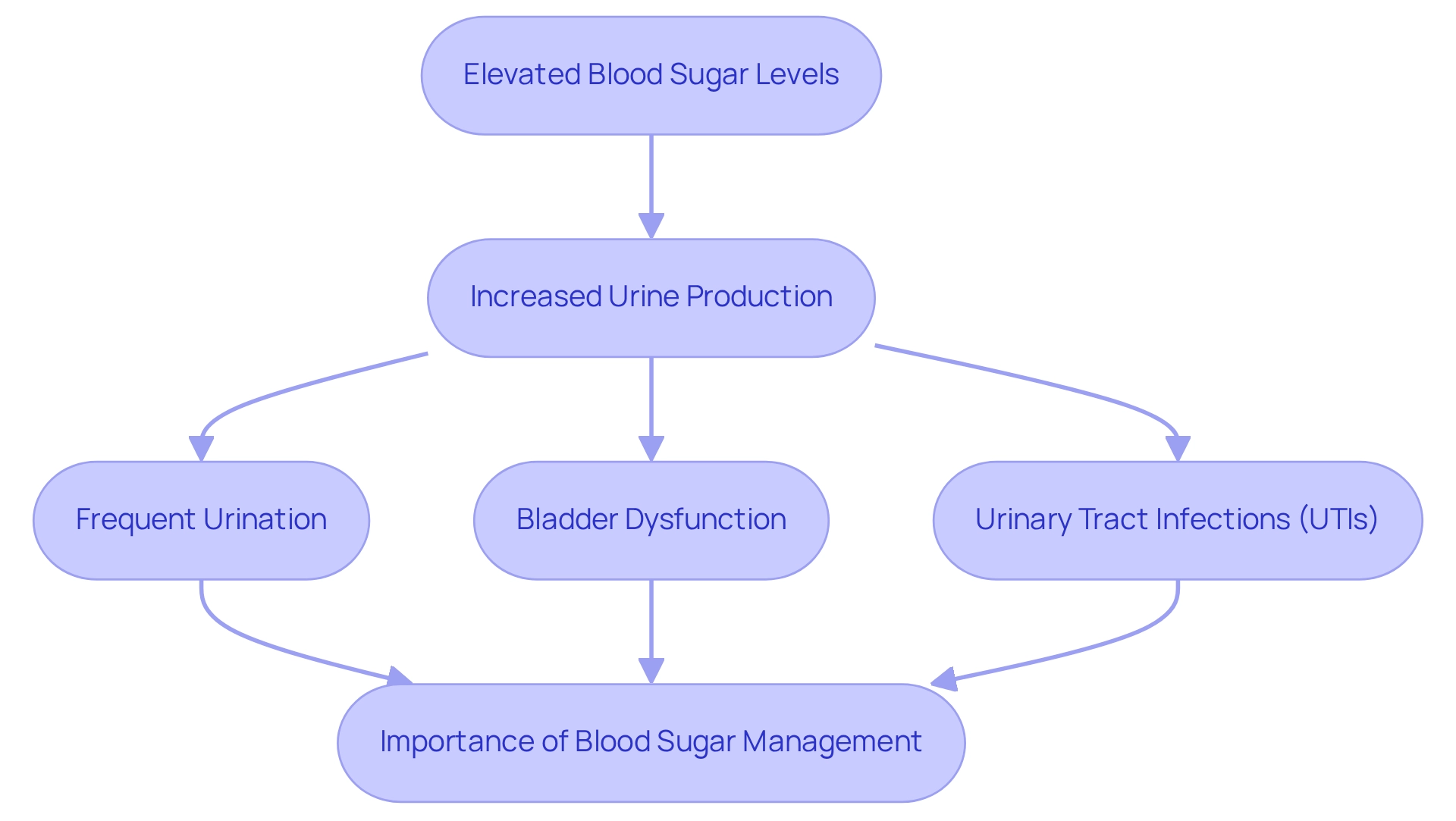
Aging and Bladder Health: What Women Need to Know
As women age, they may experience hormonal shifts, particularly during menopause. These changes can lead to weakened pelvic floor muscles and increased urinary urgency, particularly in constant peeing females. It’s common to notice a decrease in the bladder’s capacity, which can result in a constant peeing female and more frequent trips to the bathroom. Understanding these changes is essential for women.
By adopting preventive measures, such as:
- Pelvic floor exercises
- Making lifestyle adjustments
you can maintain bladder health and reduce the risk of incontinence. We are here to help you through this process.
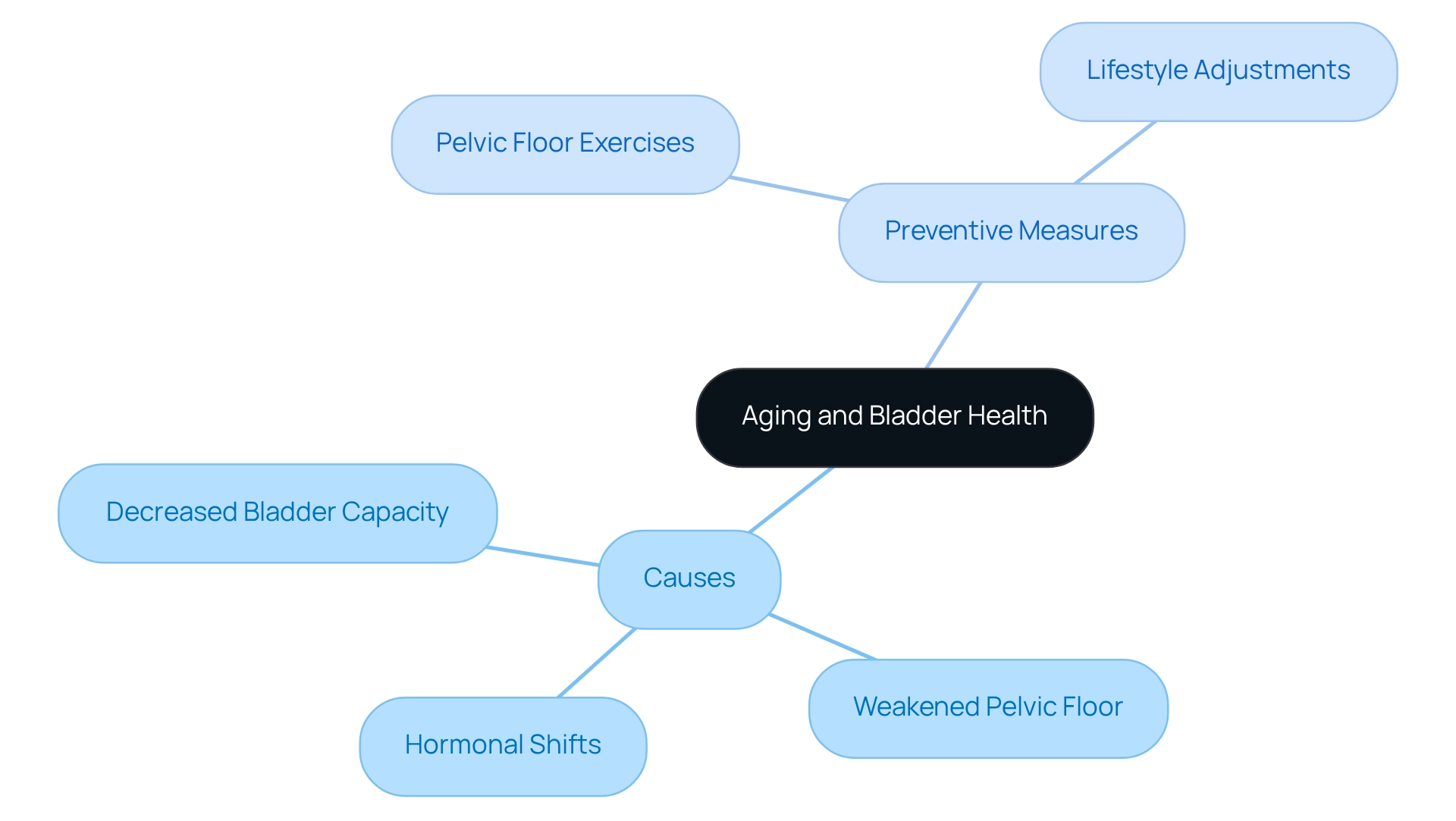
Mindfulness Techniques for Managing Urgency in Women
Mindfulness techniques, such as deep breathing and meditation, can significantly aid cataract patients in managing the anxiety that often accompanies their condition. We understand that focusing on the present moment and employing relaxation strategies can help alleviate the stress that may exacerbate symptoms. Studies indicate that addressing anxiety is crucial for overall wellness, particularly for those facing vision challenges. not only fosters a sense of calm but also empowers patients to take charge of their eye care journey.
Incorporating mindfulness into daily routines can enhance body awareness, which is beneficial when navigating the emotional aspects of dealing with cataracts. Kolo Wilkinson, Clinical Nurse Lead with Tranquility Incontinence Products, emphasizes the importance of self-care and mindfulness in managing medical conditions. Additionally, psychologists suggest that addressing anxiety through mindfulness can lead to a more holistic approach to treatment, ultimately improving the quality of life for cataract patients. Overall, mindfulness techniques offer valuable tools that can complement traditional eye care treatments, helping patients maintain a positive outlook as they manage their vision health.
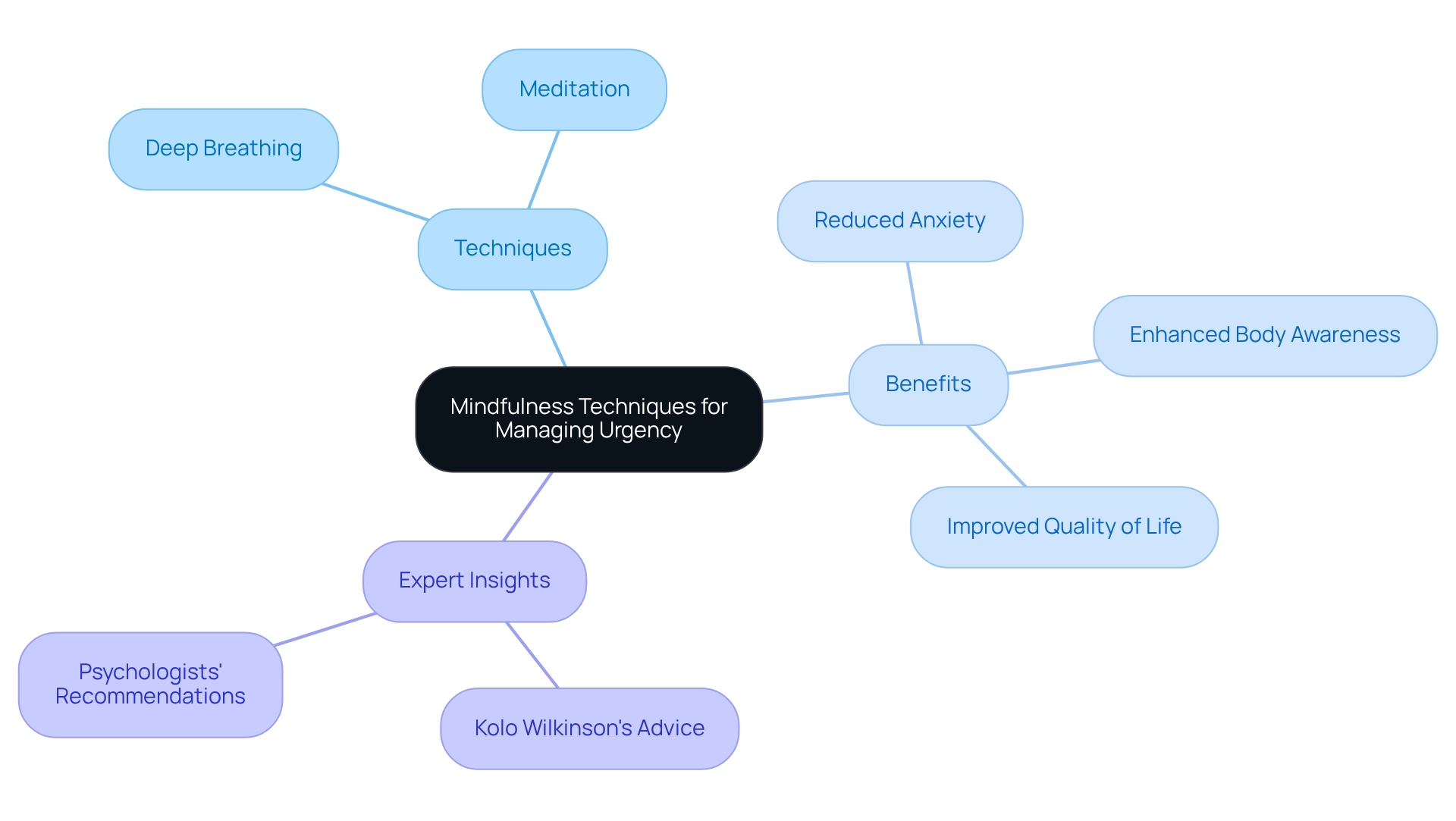
Bladder Leakage: Symptoms, Causes, and Treatment Options
Bladder leakage, known clinically as incontinence, can be a challenging experience for many. It primarily manifests as:
- Stress incontinence, which involves leakage during activities like coughing or exercising.
- Urge incontinence, characterized by a sudden, intense urge to urinate.
We understand that this condition affects a significant number of women, with studies indicating that nearly 25% of them experience constant peeing female, particularly as they age. Several factors contribute to this condition, including:
- Weakened pelvic floor muscles
- Hormonal changes—especially during menopause
- Underlying health issues such as diabetes or neurological disorders
It’s also important to recognize that lifestyle choices, like obesity and smoking, can exacerbate symptoms.
When it comes to treatment options, there is a range of alternatives tailored to individual needs. Initial management often involves lifestyle modifications, such as:
- Weight loss
- Dietary changes
- Pelvic floor exercises aimed at strengthening the muscles that support the bladder
For those who may require additional help, medications can be prescribed. However, as Dr. Holly L. Thacker notes, the ACP advises against systemic pharmacologic therapy for stress bladder incontinence. For more severe cases, surgical options are also available.
Recent case studies underscore the importance of addressing incontinence proactively. One study revealed the challenges individuals face when seeking treatment, including feelings of embarrassment and inadequate screening by healthcare providers. This highlights the need for to improve the quality of life for women, particularly for those who face constant peeing female challenges. Additionally, local therapies, such as vaginal estrogen cream, have shown promise in alleviating symptoms of bladder urgency and recurrent infections. The cost of vaginal estrogen treatments can range from $95 to $350 for 0.5 to 2 g twice weekly, which is an important consideration for many women. This suggests that hormonal therapy can be a valuable component of a comprehensive treatment plan. In cases of complicated bladder incontinence, we recommend consulting a subspecialist to ensure appropriate management.
Understanding the symptoms and causes of bladder leakage is vital for effective management. If you are experiencing bladder control issues, we encourage you to reach out to healthcare professionals who can help you explore the most suitable treatment options tailored to your specific circumstances. Remember, you are not alone in this journey, and we are here to help you through the process.
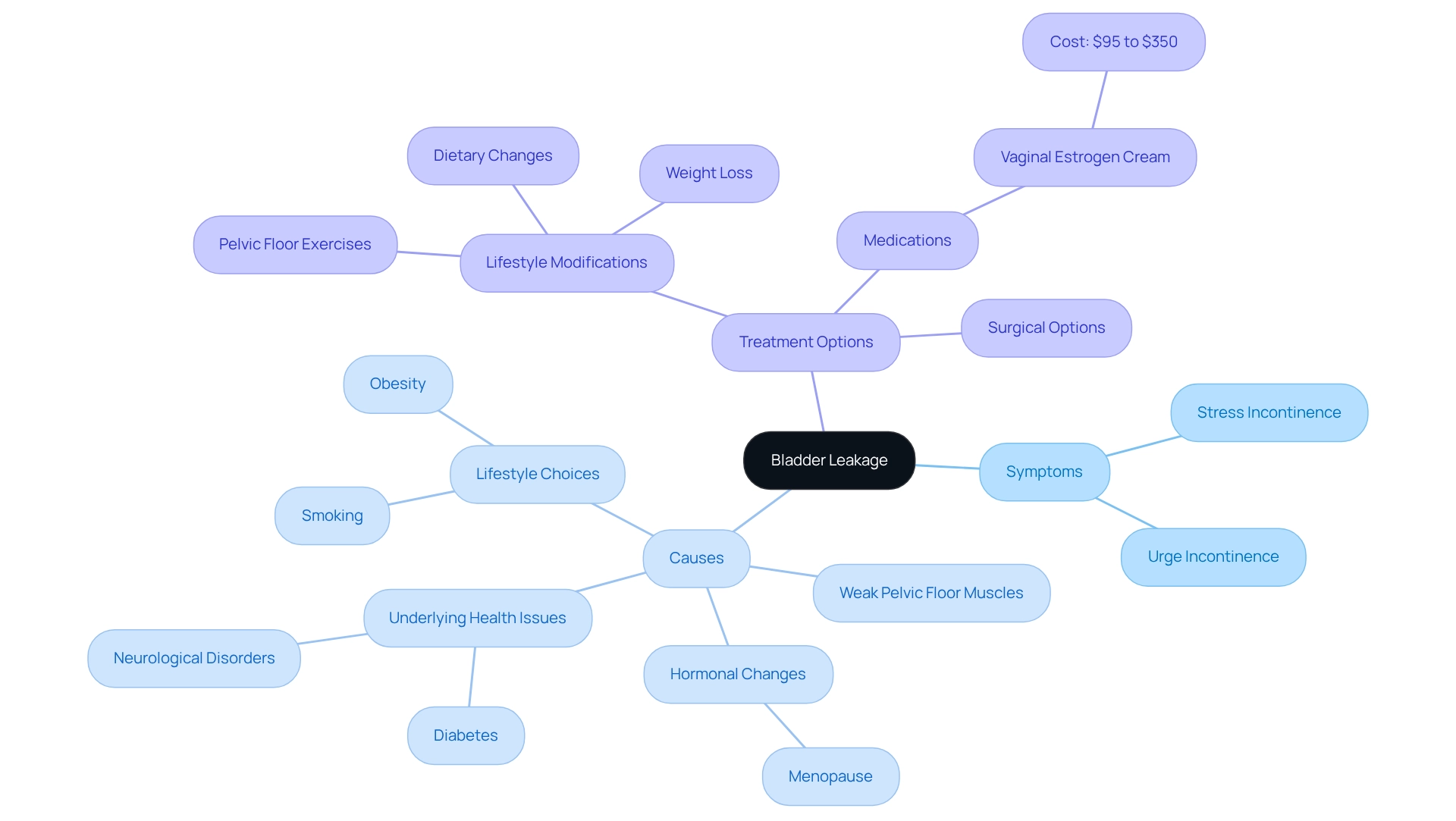
Recognizing Signs of Urinary Incontinence: When to Seek Help
Experiencing bladder incontinence can be challenging, often characterized by:
- A constant urge to urinate
- Involuntary leakage during physical activities
- An overwhelming urge to urinate that feels difficult to control
The symptoms can significantly impact your daily life, leading to emotional distress and social withdrawal. If you are a woman facing issues related to bladder incontinence, please know that you should not hesitate to consult a healthcare provider, especially if these symptoms disrupt your routine or cause anxiety. We understand that early intervention is crucial; it can lead to a proper diagnosis and a personalized treatment plan tailored to your needs.
Treatment options may include:
- Behavioral therapies
- Medications
- Surgical interventions
These options depend on the severity and underlying causes of your condition. It’s important to recognize that many individuals experience urinary incontinence, yet many do not seek assistance due to stigma or a lack of awareness. According to the American Urogynecologic Society, “Do not perform cystoscopy, urodynamics, or diagnostic renal and bladder ultrasonography in the initial workup of .” This emphasizes the importance of obtaining a proper diagnosis without unnecessary procedures.
Furthermore, vaginal estrogen (estradiol [Estrace], estrogen [Premarin]) is prescribed at a cost ranging from $95 to $350, which can be a significant factor for those exploring treatment options. We encourage you to proactively address these symptoms, as doing so can greatly improve your quality of life and overall well-being. Remember, you are not alone in this journey; we are here to help you through the process.
Risk Factors for Urinary Incontinence in Women: What to Consider
We understand that for many women, being a constant peeing female can be a source of concern related to bladder control issues. Multiple risk factors can contribute to these challenges, including:
- Age
- Obesity
- Pregnancy
- Childbirth
- Hormonal shifts during menopause
It’s common to feel overwhelmed by these factors, but recognizing them is a vital step towards empowerment.
Additionally, certain lifestyle choices, such as smoking and high-impact exercise, can exacerbate these conditions. By understanding these risk factors, women can make informed lifestyle choices that support their health. We are here to help you navigate these challenges and encourage you to seek preventive care when necessary.
Remember, you are not alone in this journey. Many women, particularly those dealing with constant peeing female issues, face similar challenges, and taking proactive steps can lead to better outcomes. Your health and well-being matter, and we are committed to supporting you every step of the way.
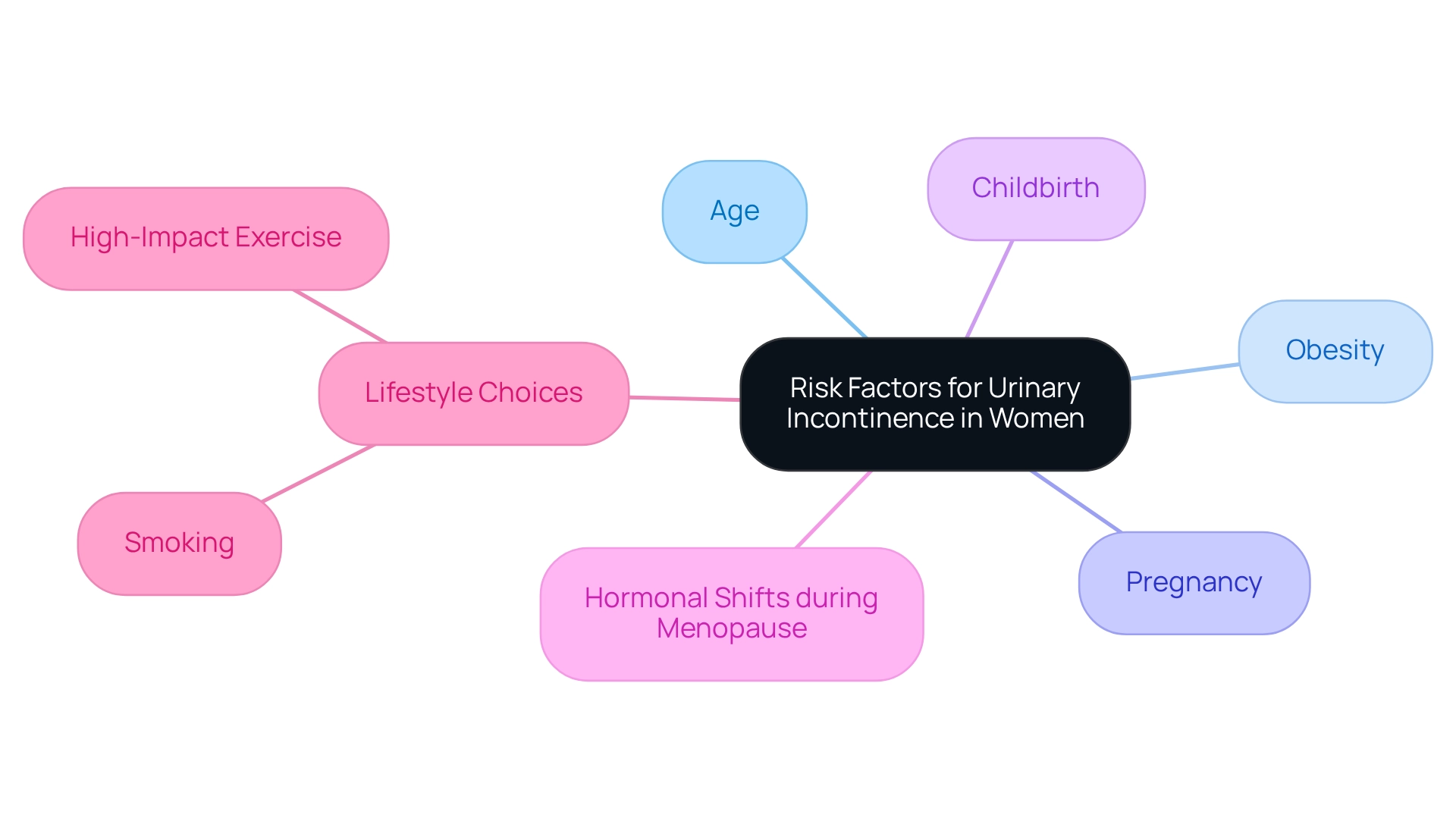
Preventing Urinary Incontinence: Effective Strategies for Women
Preventing urinary incontinence is a journey that involves a blend of lifestyle changes and pelvic floor exercises. We understand that this can be a sensitive topic, and it’s important to approach it with care. Women are encouraged to:
- Maintain a healthy weight
- Engage in regular physical activity
- Practice pelvic floor exercises, often referred to as Kegels, to significantly strengthen the muscles that support the urinary system
It’s also beneficial to avoid irritants like caffeine and alcohol, as they can exacerbate symptoms. Remember, maintaining hydration and establishing a consistent bathroom routine are simple yet effective ways to improve bladder function. We are here to help you through this process, ensuring you feel supported every step of the way.
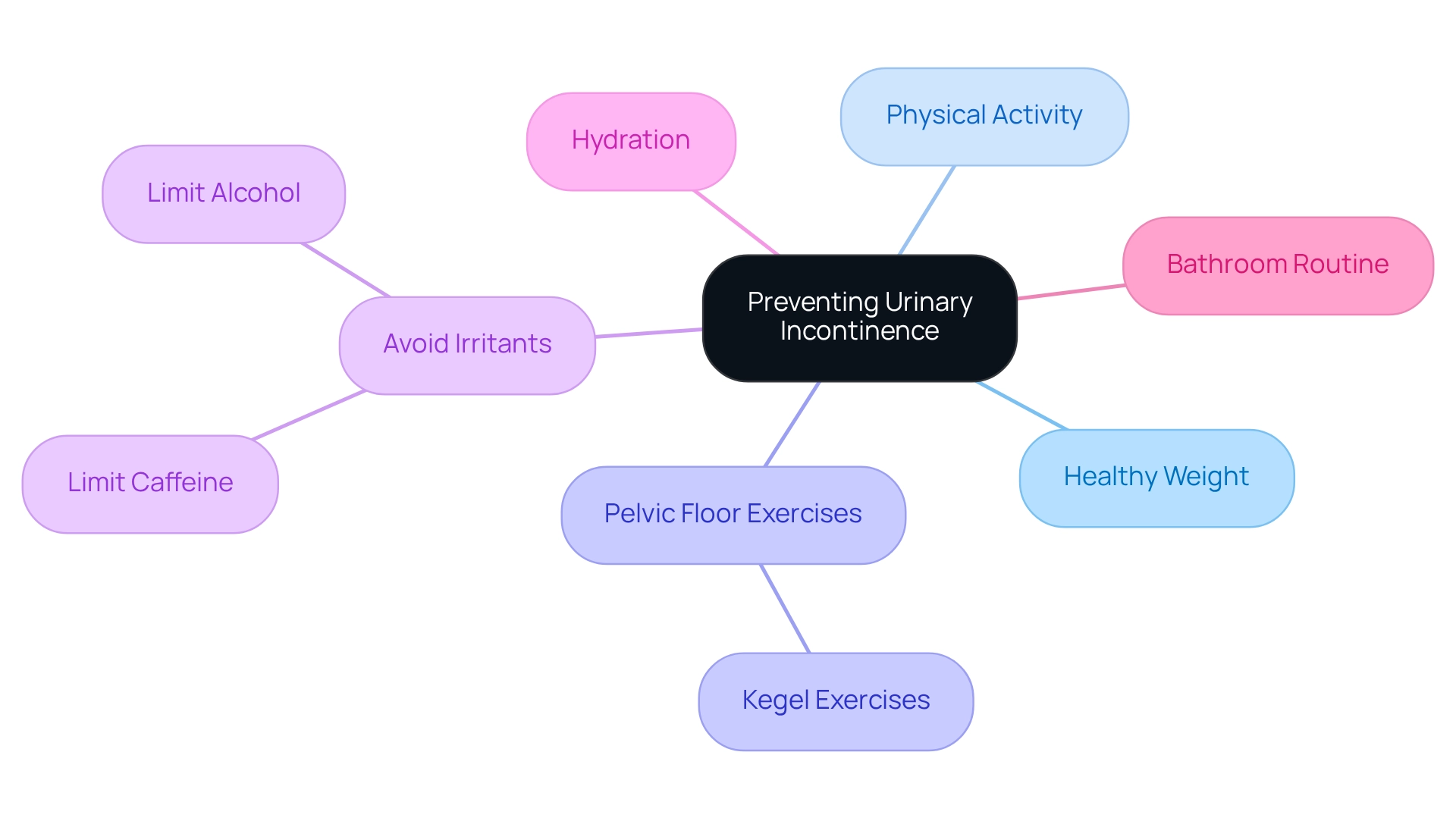
Seeking Care for Bladder Health: Treatment Options and Resources
Women facing eye conditions are encouraged to proactively seek medical attention, as prompt intervention can greatly enhance their quality of life. At Northwest Eye, we offer a variety of treatment options for eye conditions, including cataracts, which are tailored to the specific type and severity of the condition. and comprehensive eye exams aim to provide the best care possible. Many patients report substantial improvements in their vision and overall well-being following cataract surgery.
At Northwest Eye, we provide specialized services, including for conditions like glaucoma and LASIK, across multiple locations in the Twin Cities. In addition to medical treatments, numerous resources are available to assist individuals facing eye care issues. We understand that educational materials and support groups can offer valuable insights and encouragement, helping individuals feel less isolated in their experiences. Consulting with our ophthalmology professionals is essential, as they can guide patients through the numerous options available and suggest the most effective solutions for their specific needs.
Expert insights highlight the importance of addressing vision concerns promptly. Our ophthalmologists often recommend a combination of lifestyle modifications and medical treatments to optimize eye function. As we look ahead to 2025, advancements in treatment options continue to evolve, offering individuals more effective and less invasive solutions than ever before. By leveraging these resources and seeking specialized care at Northwest Eye, women can take significant steps toward managing their eye health effectively. We also offer financing programs and payment plans to make care more accessible. Testimonials from satisfied patients at Northwest Eye underscore our compassionate approach and the effectiveness of our treatments, reinforcing the importance of seeking timely care.
Conclusion
Understanding bladder health is critical, especially for women navigating various life stages and health challenges. We understand that this topic can feel overwhelming. This article has explored key aspects of bladder health, such as:
- The prevalence and management of overactive bladder
- The connection between diabetes and frequent urination
- The impact of aging on urinary function
By recognizing symptoms and understanding underlying causes, women can take proactive steps toward managing their bladder health.
The emphasis on patient education and health literacy cannot be overstated. With resources provided by healthcare professionals, women are empowered to seek timely medical advice and explore effective treatment options for conditions like urinary incontinence. It’s common to feel uncertain about these issues, but acknowledging risk factors and implementing preventive strategies, such as pelvic floor exercises and lifestyle modifications, can significantly enhance quality of life.
Ultimately, taking charge of bladder health is a vital aspect of overall well-being. By fostering awareness and encouraging open discussions about urinary issues, women can overcome stigma and access the support they need. Staying informed and proactive not only contributes to individual health management but also strengthens community efforts to improve women’s health outcomes. Remember, we are here to help you through this process, and together we can navigate these challenges.
Frequently Asked Questions
What is the focus of Northwest Eye regarding patient education?
Northwest Eye emphasizes thorough patient education on urinary well-being, particularly for women experiencing bladder issues like constant peeing.
Why is health literacy important for urinary wellness?
Health literacy is crucial as it impacts outpatient surgery recovery and care-related quality of life, helping patients better understand and manage their urinary health.
What are common symptoms of Overactive Bladder (OAB)?
Common symptoms of OAB include a sudden, uncontrollable urge to urinate, frequent urination (more than seven times in 24 hours), and nocturia, which is waking at night to urinate.
What factors can influence Overactive Bladder in women?
Factors influencing OAB in women include muscle overactivity, neurological disorders, lifestyle choices like high caffeine consumption, and hormonal changes, particularly during menopause.
How can lifestyle modifications help manage OAB symptoms?
Reducing caffeine intake and maintaining a healthy weight can significantly alleviate symptoms of OAB.
What treatment strategies are effective for women with OAB?
Effective treatment strategies often involve a combination of behavioral therapies, such as bladder training, and pharmacological interventions.
What is the relationship between diabetes and bladder function?
Individuals with diabetes may experience frequent urination due to elevated blood sugar levels, which can lead to bladder issues and complications like urinary tract infections.
What percentage of women with diabetes experience bladder-related complications?
Studies indicate that nearly 20-40% of diabetic women experience bladder-related complications, including symptoms of constant peeing.
What management strategies are recommended for individuals with diabetes to alleviate bladder symptoms?
Expert recommendations include managing blood sugar levels through a balanced diet, regular exercise, and appropriate medication to alleviate bladder symptoms and improve overall well-being.
Why is ongoing research important for understanding the impact of diabetes on bladder function?
Ongoing research is vital to explore the complex relationship between high blood sugar levels and increased urination, ensuring effective intervention and management for women with diabetes.






